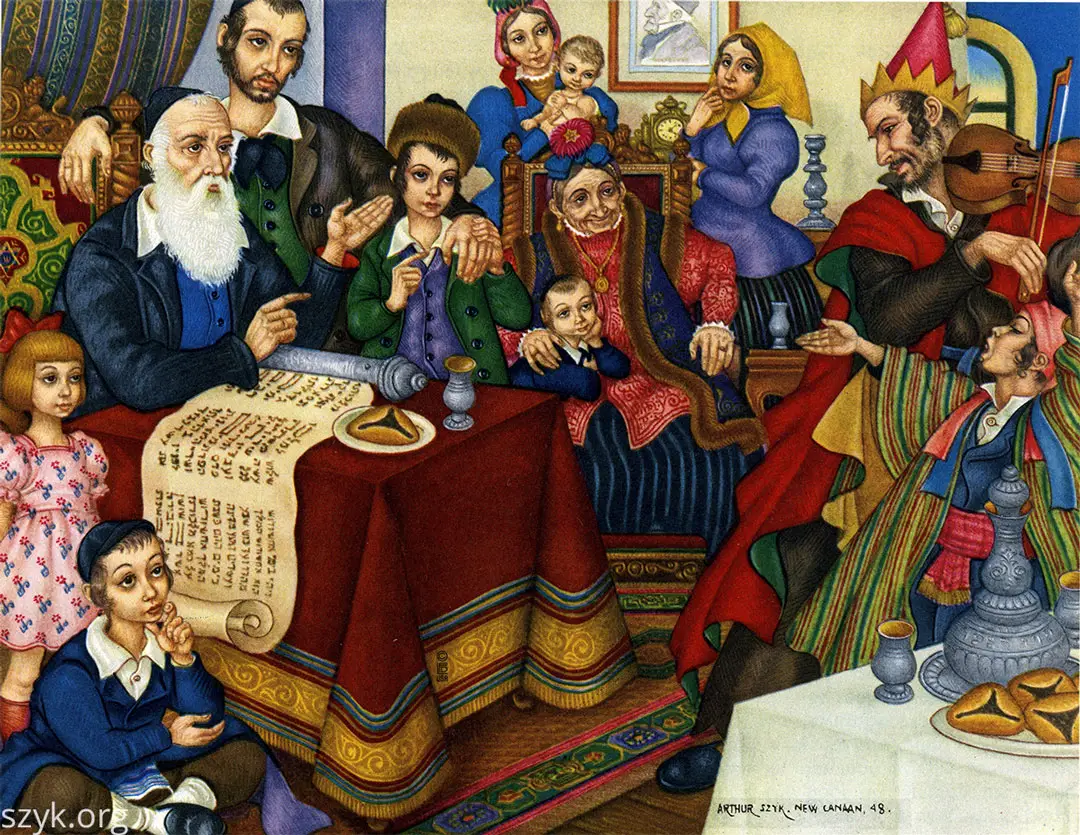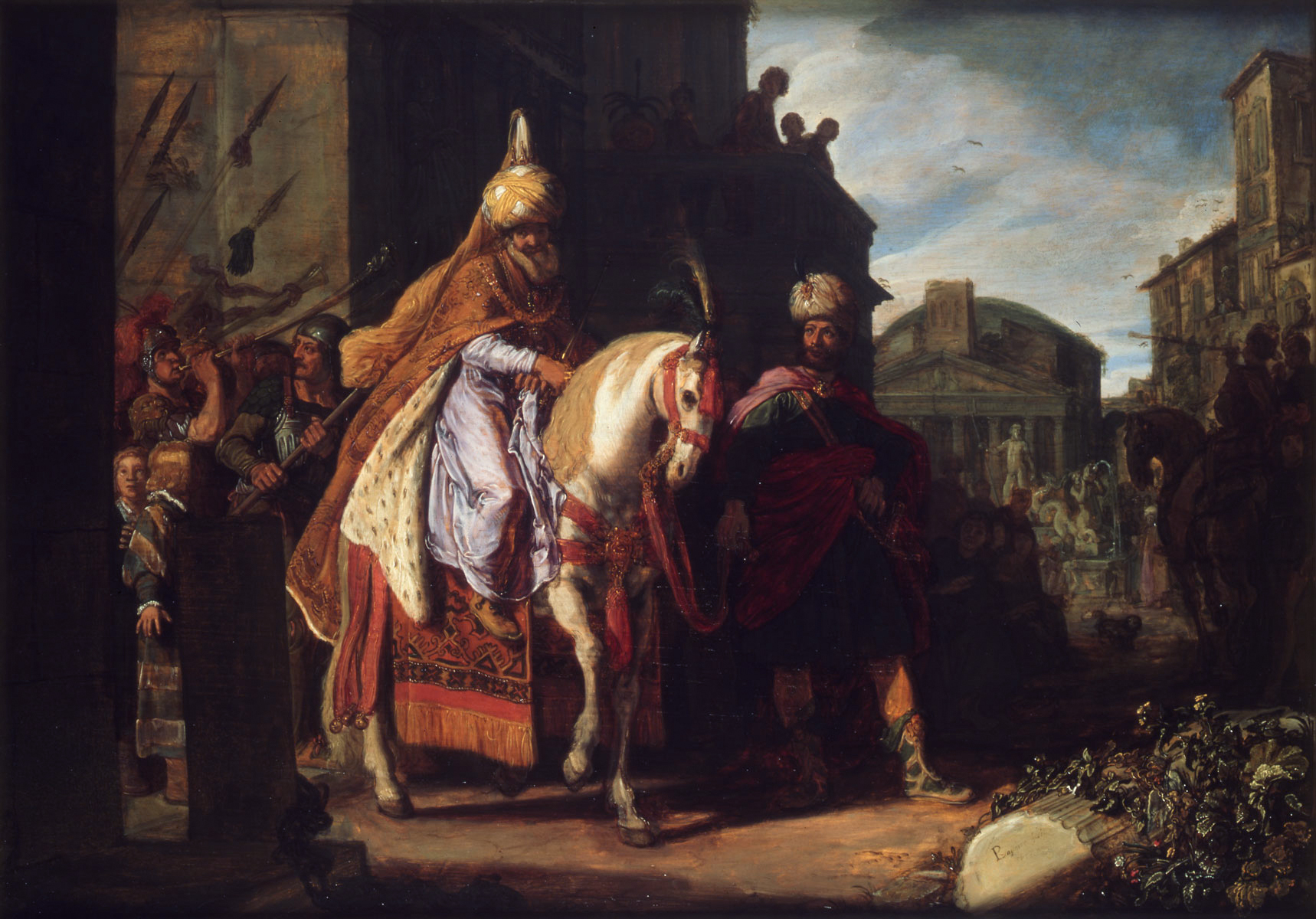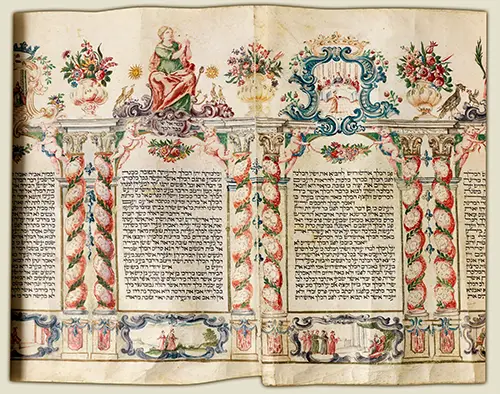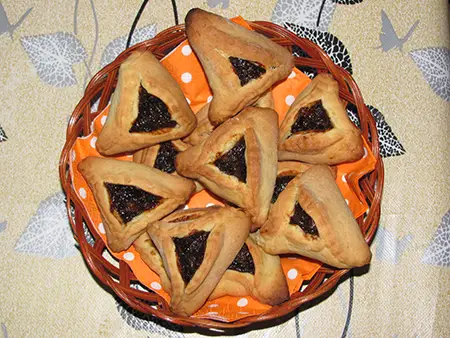Jewish Holidays: Purim

Purim (Heb. פּוּרִים) is one of the most joyous and fun holidays on the Jewish calendar. It commemorates a time when the Jewish people living in Persia were saved from extermination.
The story of Purim is told in the Biblical book of Esther. The heroes of the story are Esther, a beautiful young Jewish woman living in Persia, and her cousin Mordecai, who raised her as if she were his daughter. Esther was taken to the house of Ahasuerus, King of Persia, to become part of his harem, and he loved her more than his other women and made her queen. But the king did not know that Esther was a Jew because Mordecai told her not to reveal her nationality.
 |
The villain of the story is Haman, an arrogant, egotistical advisor to the king. Haman hated Mordecai because Mordecai refused to bow down to Haman, so Haman plotted to destroy the Jewish people. In a speech that is all too familiar to Jews, Haman told the king, “There is a certain people scattered abroad and dispersed among the peoples in all the provinces of thy kingdom; and their laws are diverse from those of every people; neither keep they the king’s laws; therefore it does not profit the king to suffer them” (Esther 3:8). The king gave the fate of the Jewish people to Haman, to do as he pleased to them. Haman planned to exterminate all of the Jews.
Purim (Akk. pūrū, “lots”) is so-called (Esther 9:26) after the lots cast by Haman to determine the month in which the slaughter was to take place (Esther 3:7). In Hasmonean times it was known as the “Day of Mordecai” (II Macc. 15:36)
Mordecai persuaded Esther to speak to the king on behalf of the Jewish people. This was a dangerous thing for Esther to do, because anyone who came into the king’s presence without being summoned could be put to death, and she had not been summoned. Esther fasted for three days to prepare herself, then went to the king. He welcomed her. Later, she told him of Haman’s plot against her people. The Jewish people were saved, and Haman was hanged on the gallows that had been prepared for Mordecai.
The book of Esther is unusual in that it is the only book of the bible that does not contain the name of G-d. In fact, it includes virtually no reference to G-d. Mordecai makes a vague reference to the fact that the Jews will be saved by someone else, if not by Esther, but that is the closest the book comes to mentioning G-d. Thus, one important message that can be gained from the story is that G-d often works in ways that are not apparent, in ways that appear to be chance, coincidence or ordinary good luck.
The chronological difficulties such as the identity of King Ahasuerus, and the absence of any reference in the Persian sources to a king having a Jewish consort; the striking resemblance between the names Mordecai and Esther to the Babylonian gods Marduk and Ishtar; the lack of any reference to Purim in Jewish literature before the first century B.C.E.; the language of the Book of Esther, which suggests a later date – all these have moved the critics to look elsewhere than the account in Esther for the true origin of the festival. Various conjectures have been made but the problem still awaits its solution.
The festival had long been established by the second century C.E. when a whole tractate of the Mishnah (Megillah) was devoted to the details of its observance, especially to the rules governing the reading of the Scroll of Esther, called in the rabbinic literature the megillah (“scroll”).
Purim is celebrated on the 14th day of Adar, which is usually in March. The 14th of Adar is the day that Haman chose for the extermination of the Jews. In leap years, when there are two months of Adar, Purim is celebrated in the second month of Adar, so it is always one month before Passover. In cities that were walled in the time of Joshua, Purim is celebrated on the 15th of the month, because the book of Esther says that in Shushan (a walled city), deliverance from the massacre was not complete until the next day (Esther 9:18). This day became known as Shushan Purim.
Out of respect for Jerusalem, it is said, the day is still kept by Jews living in cities that had a wall around them “from the days of Joshua“ (Meg. l:1). Thus, in present-day Israel, Purim is celebrated in Jerusalem on the 15th, but in Tel Aviv on the 14th.
The Purim holiday is preceded by a minor fast, the Fast of Esther, which commemorates Esther’s three days of fasting in preparation for her meeting with the king.
The primary commandment related to Purim is to hear the reading of the book of Esther –the Megillah. Although there are five books of Jewish scripture that are properly referred to as megillahs (Esther, Ruth, Ecclesiastes, Song of Songs, and Lamentations), this is the one people usually mean when the speak of The Megillah.

Esther Scroll
Megillot are frequently decorated, sometimes with scenes from the narrative. Since according to the midrashic interpretation the word ha-melekh (“the king”), when it is not qualified by Ahasuerus, refers to the King of the universe, some megillot are so written that each column begins with this word. It would seem that originally the megillah was read during the day, but eventually, the rule was adopted to read it both at night and during the day (Meg. 4a). It is customary to fold the megillah over and spread it out before the reading since it is called a “letter” (Esther 9:26, 29).
The megillah is read with a special cantillation. The four verses of “redemption” (2:5; 8:15–16; and 10:3) are read in a louder voice than the other verses. It is customary to boo, hiss, stamp feet, and rattle gragers (noisemakers) whenever the name of Haman is mentioned in the service. The purpose of this custom is to “blot out the name of Amalek.” (see Deut. 25:19, and Esther 3:1 and I Sam. 15:8–9 for Haman was a descendant of Amalek). It is the practice for the reader to recite the names of the 10 sons of Haman (Esther 9:7–9) in one breath (Meg. 16b) to show that they were executed simultaneously. The custom has also been seen, however, as a refusal by Jews to gloat over the downfall of their enemies (C.G. Montefiore and H. Loewe (ed.), A Rabbinic Anthology (1938), 53).
We are also commanded to eat, drink and be merry. There has been much discussion around the saying of the Babylonian teacher Rava (Meg. 7b) that a man is obliged to drink so much wine on Purim that he becomes incapable of knowing whether he is cursing Haman or blessing Mordecai. The more puritanical teachers tried to explain this away, but the imbibing of alcohol was generally encouraged on Purim, and not a few otherwise sober teachers still take Rava’s saying literally (see, e.g., H. Weiner: 9½ Mystics (1969), 207). The laws of Purim and the reading of the megillah are codified in Shulḥan Arukh, OḤ 686–97.
Various parodies of sacred literature were produced for Purim, the best known of which, Massekhet Purim, is a skillful parody of the Talmud with its main theme the obligation to drink wine merrily and to abstain strictly from water. The institution of the Purim rabbi, a kind of lord of misrule, who recites Purim Torah, the frivolous manipulation of sacred texts, was the norm in many communities. Some have seen in all this an annual attempt to find psychological relief from what otherwise might have become an intolerable burden of loyalty to the Torah (Druyanow, Reshumot, 1 and 2). Under the influence of the Italian carnival it became customary for people to dress up on Purim in fancy dress, men even being permitted to dress as women and women as men. The Adloyada carnival in Tel Aviv has been a prominent feature of Purim observance in modern Israel.
In the Kabbalistic and Hasidic literature much is made of Purim as a day of friendship and joy and as the celebration of God at work, as it were, behind the scenes, unlike Passover which celebrates God’s more direct intervention. The “lots” of Purim are compared with the “lots” cast on the Day of Atonement (Lev. 16:8), what human beings call “fate” or “luck” being, in reality, only another manifestation of God’s providential care. So highly did the kabbalists esteem Purim that they reported in the name of Isaac Luria that the Day of Atonement is “like Purim” (Yore ke-Furim).
While some Reform congregations abolished Purim, others continued to celebrate it as a day of encouragement and hope, some even arguing that it helped Jews to express their aggressive emotions and to sublimate their feelings of wrath and hatred (W.G. Plaut, The Growth of Reform Judaism (1965), 224).
Jews are commanded (Esther 9:18) to send out gifts of food or drink and to make gifts to charity. The sending of gifts of food and drink is referred to as shalach manos (lit. sending out portions). The rule is to send at least two “portions” of eatables, confectionery, and so forth, to a friend and to give a present of money to at least two poor men.
 |
A special festive meal is eaten on Purim afternoon toward eventide. Among the special Purim foods are boiled beans and peas, said to be a reminder of the cereals Daniel ate in the king’s palace to avoid any infringement of the dietary laws. Among Ashkenazic Jews, a common treat at this time of year is hamentaschen (lit. Haman’s pockets). There are many explanations as to why Jews eat these tri-cornered pastries on Purim, including that they are meant to represent Haman’s hat, or ears. Nobody knows for sure how these sweets became so heavily associated with Purim, but we do know that similar cookies known as Mohntaschen were popular in 18th-century Europe, and they were adopted around this time as a Purim treat by European Jewish families. It is speculated that these cookies became a traditional Purim food because the word “Mohn,” of Mohntaschen, sounds similar to the name Haman. This association caught on, and soon the cookies were simply known as hamentaschen. During the 19th century the cookies spread to America and the rest of the world, and have remained a Purim staple ever since.
It is customary to hold carnival-like celebrations on Purim, to perform plays and parodies, and to hold beauty contests.
The Torah reading for Purim morning is Exodus 17:8–16. Work is permitted as usual on Purim unless it falls on a Saturday. Purim is considered a minor holiday reflected in the Yiddish saying that as a high temperature does not denote serious illness neither is Purim a festival.
See also Purim recipes.
BIBLIOGRAPHY
N.S. Doniach, Purim (Eng., 1933); S. Zevin, Ha-Mo'adim ba-Halakhah (196310), 188–214; J.D. Epstein, Oẓar ha-Iggeret (1968); P. Goodman, Purim Anthology (1960), incl. bibl.; J.L. Fishman, Ḥagim u-Mo'adim (1944), 119–68: J.H. Greenstone, Jewish Feasts and Fasts (1945), 135–78; H. Schauss, Jewish Festivals (1938), 237–71.
Sources: Judaism 101.
Haaretz, (March 2, 2015).
Encyclopaedia Judaica. © 2007 The Gale Group. All Rights Reserved.
Photos: Purim painting by Arthur Szyk, Public domain via Wikimedia Commons.
Esther scroll - Israel Museum, Public domain via Wikimedia Commons.
Pieter Lastman, Public domain via Wikimedia Commons.


